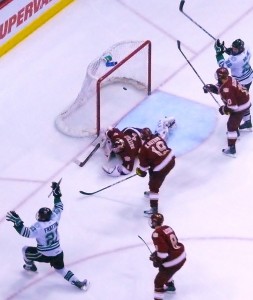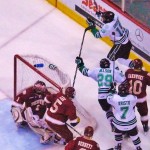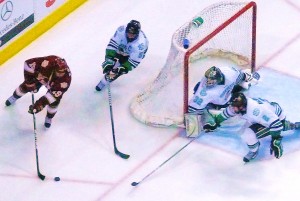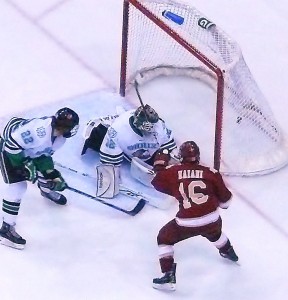Frattin, Sioux win Broadmoor Cup in 2OTs

Matt Frattin (21) reacts after shooting past Denver goalie Sam Brittain for North Dakota's 3-2 double-overtime victory.
By John Gilbert
SAINT PAUL, MN. — For the second straight night, North Dakota had to turn to scoring champion and Hobey Baker finalist Matt Frattin for the game-winning goal, but this time he made 16,731 fans at Xcel Energy Center wait until the second overtime before scoring to boost the Fighting Sioux to a 3-2 victory over Denver in the WCHA Final Five championship game.
Frattin, who scored the winner with 5:40 remaining in North Dakota’s 4-3 semifinal victory over Colorado College, was the recipient of a collaboration with two of his fellow-seniors at 5:11 of the second sudden-death overtime session. Frattin’s quick work with a blocked shot brought him his 35th goal of the season and brought North Dakota the Broadmoor Cup. It also sends the Sioux flying into the NCAA tournament with a 29-8-3 record.
The three seniors who worked on the game-winning play are part of the “Magnificent Seven” Sioux seniors. Evan Trupp, summoning a burst of energy while players on both teams seemed to be running down from exhaustion, sped up the right side, and when he was checked away from the net, Trupp curled to the right corner and passed back to the right point. Chay Genoway cut loose from there with a big shot that was blocked, but the carom went wide to the left of the goal, where Frattin one-timed it before Denver goalie Sam Brittain could react.
“I don’t know where Trupp got the energy,” said Frattin. “He’s the Energizer Bunny. He gets his legs going and lifts the whole team. Then Chay got a good shot, and the rebound came right to me. Scoring this goal was right on top. The way they were playing, I didn’t think it was going to end anytime soon.”
It was Frattin’s seventh game-winning goal of the season, prompting coach Dave Hakstol to explain things in the post-game press conference. “We have a rule on this team,” deadpanned Hakstol, “that if you enter the offensive zone with the puck, and Frattin is on the ice, you have to give it to him.”
More seriously, Hakstol said: “We started with a quest to win the Broadmoor Cup, and we had to win four games to do it. Tonight, Denver had the better opportunities for 60 minutes, and the first few minutes of overtime, but we got a little rhythm in the second half of the first overtime, and it carried over to the second overtime. The bottom line is, we got a bounce, and it happened to land on the right guy’s stick.”
Denver, the season runner-up to the Sioux, is also assured of an NCAA berth with a 24-11-5 mark, and played a strong game to outshoot the Sioux 42-36 and force the overtime when Anthony Maiani came up with the equalizer with 2:13 left in the third period.
“We found ways to win our last four games,” said Denver coach George Gwozdecky. “We lost tonight, but to if we can play the league champion in a game like this, it’s a great thrill, a privelege, and an honor. The first eight or nine minutes of the first overtime, we played well, then we got a little loose defensively and gave gthem some chances, and Sam made some great saves to keep the puck out of the net.”
The Fighting Sioux spotted Denver a 1-0 lead in the first period, then scored twice in the first eight minutes of the second in the match of the WCHA’s top two physical heavyweights. Sometimes it seemed the physical play was more of a focal point than the game itself, particularly to the Fighting Sioux, who obviously wanted to knock the Pioneers off their game. Many college hockey games show an assortment of interference and tripping calls; not these guys. The 16 minor penalties in the three regulation periods had one interference and one for hooking, while the other 14 were six slashings, three roughings, three cross-checks, one boarding, and a face-masking.
The hitting and the ensuing chippiness detracted from the speed and flow that both teams are capable of, but it added an extra edge to the drama being played out over three periods, and on into overtime. Bodies continued to fly in the overtime, but the teams throttled back enough that the officials could put away their whistles and let the lads play. “They let the players decide the game,” said Hakstol.
Five minutes into the first period, Denver’s Kyle Ostrow and Maiani were forechecking deep, behind the Sioux goal, and Ostrow passed the puck out to the slot, where Dustin Jackson arrived just in time to hammer a quick shot before North Dakota goaltender Aaron Dell could react, giving the Pioneers an early 1-0 lead.
Fighting Sioux center Brad Malone and winger Brett Hextall were the most aggressive body-checkers, and when Malone threw a heavy hit after a whistle, igniting a small scuffle at the Sioux bench, he went off for boarding at 7:44, but North Dakota killed off the power play. Later in the period, the Sioux also found it difficult to generate anything at the other end on a power play, and the period ended 1-0 with Denver also holding a 10-6 edge in shots.
North Dakota responded with both its regulation goals early in the second period, both of which could have listed good luck in the assist bracket. At 2:32, Denver goaltender Sam Brittain blocked a shot that was just wide to the right, and when Danny Kristo tried to chip the rebound, he partially fanned on his shot and Pioneer center Nick Shore, closing in to defend, inadvertently kicked the puck and it wound up in the net for a 1-1 tie.

Brent Davidson, top, gave North Dakota a 2-1 lead with a bank shot from behind the net, off Denver goalie Sam Brittain.
A few minutes later, North Dakota killed Dillon Simpson’s cross-checking penalty, and Sioux left winger Brent Davidson broke across center ice, catching a pass, and breaking hard on the right side. A defender knocked the puck away from him, but Davidson got to it first on the end boards, then spun half way around and flipped it out front. The puck hit Brittain’s skate and the ricochet went in at 8:18 for a 2-1 Sioux lead.
Playing aggressively seemed to be in North Dakota’s favor, and even when they took penalties the Fighting Sioux kept attacking and got several good scoring chances short-handed. Corban Knight nearly made it 3-1 when he wound up with the puck and shot for the open right side of the net, but suddenly it wasn’t open, as Brittain dived across the crease and snared the shot with his glove.
The hitting took a couple tolls. Denver freshman scoring whiz Jason Zucker absorbed a knockdown from Hextall, and he didn’t return to his first-line post for most of the second period with an “upper body” injury. And as the period ended, Sioux defenseman and captain Genoway and a Denver player collided at the buzzer, and Genoway limped off the ice and was helped to the dressing room. Both returned to regular service in the third period, however.

Denver's Kyle Ostrow outflanked Sioux defensemen Chay Genoway and Andrew MacWilliam (2), and goalie Aaron Dell, who made 40 saves.
The third period was another exercise in penalty killing, as neither team seemed willing to concentrate on just hockey, with so many physical challenges being offered. As the minutes passed, however, the Pioneers grew more intense, and fought through the checks for enough openings to establish an 11-4 edge in shots. At 17:47, after all the close checking, Denver caught the Sioux in a rare coverage lapse. The puck went out to the left point, and Matt Donovan passed ahead to a wide-open Beau Bennett, deep in the left corner. All alone, Bennett hesitated to let Maiani get clear of any checkers on the far side of the slot, then he sent him a perfect pass, and Maiani banged it in for the 2-2 deadlock.
Both sides had scoring chances in the first overtime, a 20-minute session, with Dell stopping 10 Denver shots, and Brittain 11, although North Dakota had the more dangerous threats. Brittain came up with a great glove save on Frattin, then stopped Taylor Dickinson’s break-in and also got Kristo’s follow-up. His best, though, was when Trupp was open for a point-blank one-timer, and Brittain kicked his left leg out and blocked the shot with his toe, just inside the right pipe.
Brittain came up with another similar toe save in the second overtime, and was ready for Genoway’s blast minutes later, but he had no chance on Frattin’s wide-angle winner.
Comments
Tell me what you're thinking...
and oh, if you want a pic to show with your comment, go get a gravatar!



 John Gilbert is a lifetime Minnesotan and career journalist, specializing in cars and sports during and since spending 30 years at the Minneapolis Tribune, now the Star Tribune. More recently, he has continued translating the high-tech world of autos and sharing his passionate insights as a freelance writer/photographer/broadcaster. A member of the prestigious North American Car and Truck of the Year jury since 1993. John can be heard Monday-Friday from 9-11am on 610 KDAL(www.kdal610.com) on the "John Gilbert Show," and writes a column in the Duluth Reader.
John Gilbert is a lifetime Minnesotan and career journalist, specializing in cars and sports during and since spending 30 years at the Minneapolis Tribune, now the Star Tribune. More recently, he has continued translating the high-tech world of autos and sharing his passionate insights as a freelance writer/photographer/broadcaster. A member of the prestigious North American Car and Truck of the Year jury since 1993. John can be heard Monday-Friday from 9-11am on 610 KDAL(www.kdal610.com) on the "John Gilbert Show," and writes a column in the Duluth Reader.